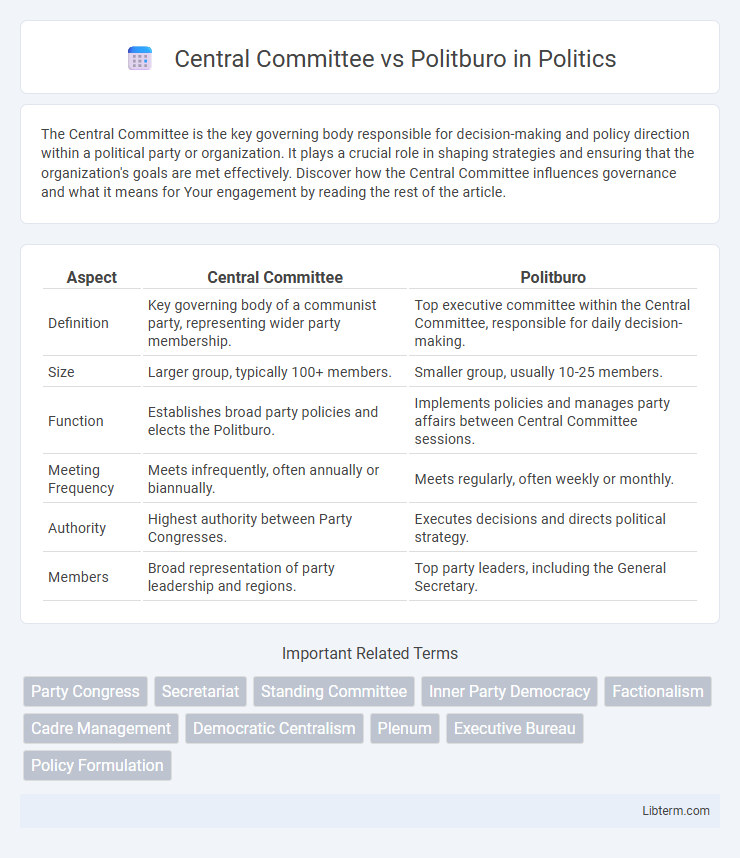The Central Committee is the key governing body responsible for decision-making and policy direction within a political party or organization. It plays a crucial role in shaping strategies and ensuring that the organization's goals are met effectively. Discover how the Central Committee influences governance and what it means for Your engagement by reading the rest of the article.
Table of Comparison
| Aspect | Central Committee | Politburo |
|---|---|---|
| Definition | Key governing body of a communist party, representing wider party membership. | Top executive committee within the Central Committee, responsible for daily decision-making. |
| Size | Larger group, typically 100+ members. | Smaller group, usually 10-25 members. |
| Function | Establishes broad party policies and elects the Politburo. | Implements policies and manages party affairs between Central Committee sessions. |
| Meeting Frequency | Meets infrequently, often annually or biannually. | Meets regularly, often weekly or monthly. |
| Authority | Highest authority between Party Congresses. | Executes decisions and directs political strategy. |
| Members | Broad representation of party leadership and regions. | Top party leaders, including the General Secretary. |
Introduction: Understanding Central Committee and Politburo
The Central Committee serves as the primary governing body within many communist parties, responsible for major policy decisions and electing key leadership such as the Politburo. The Politburo functions as the executive committee, managing day-to-day political operations and implementing the Central Committee's directives. Together, these bodies establish the hierarchical structure essential for party governance and strategic decision-making.
Historical Origins of the Central Committee
The Central Committee originated in the early 20th century as the principal governing body of communist parties, designed to oversee party activities between congresses and to implement decisions of the party congress. Historically, it emerged from the Bolshevik Party's need for a collective leadership structure following the 1903 Congress, solidifying its role by the time of the 1917 Russian Revolution. The Politburo, created shortly after in 1917, served as a smaller, more powerful executive committee drawn from the Central Committee to handle day-to-day political decision-making and maintain party control.
The Emergence of the Politburo
The emergence of the Politburo marked a pivotal shift in Communist Party governance, consolidating decision-making power within a smaller, more efficient group compared to the broader Central Committee. Originally, the Central Committee acted as the main governing body, but its large size led to slower, less cohesive policy decisions. The Politburo was established to expedite strategic leadership and manage day-to-day operations, enhancing centralized control and responsiveness within Communist states.
Structural Differences Between Central Committee and Politburo
The Central Committee serves as a broader representative body within communist party hierarchies, often comprising hundreds of members who meet periodically to set major policies and elect key leadership positions. In contrast, the Politburo is a smaller, more elite executive group selected from the Central Committee, responsible for daily decision-making and strategic direction between Central Committee sessions. Structurally, the Central Committee emphasizes collective leadership and broad member participation, while the Politburo operates as a streamlined, centralized authority with concentrated power and quicker responsiveness.
Key Functions and Responsibilities
The Central Committee serves as the principal policymaking body within a communist party, responsible for electing the Politburo, approving major policies, and guiding party strategy between congresses. The Politburo functions as the executive committee, handling daily decision-making, overseeing implementation of party directives, and managing state affairs. Together, these entities ensure centralized control, with the Central Committee shaping broad objectives and the Politburo executing tactical governance.
Membership Composition: Selection and Criteria
The Central Committee comprises several hundred members elected by the Party Congress, representing broad sectors and regions to ensure diverse party representation. The Politburo is a smaller, elite group selected from the Central Committee members, chosen for their political loyalty, leadership experience, and strategic importance within the party hierarchy. Membership in the Politburo often reflects a combination of ideological alignment, proven administrative skills, and factional balance within the party.
Decision-Making Powers: Who Holds Authority?
The Politburo holds the highest decision-making authority within a Communist Party, responsible for shaping key policies and directing party activities between Central Committee meetings. The Central Committee, comprising a larger group of party officials, acts as a supervisory body that formally approves decisions but generally defers to the Politburo's leadership. While the Central Committee has the theoretical power to influence major decisions, the Politburo exercises practical control and holds executive authority in governance and party strategy.
Interactions Between Central Committee and Politburo
The Central Committee serves as the broader governing body within communist party structures, while the Politburo functions as the executive committee directing day-to-day political decisions. Interactions between the Central Committee and Politburo involve periodic plenary sessions where the Politburo reports on policy implementation and seeks guidance, ensuring alignment with the committee's strategic objectives. The Politburo's decisions are subject to Central Committee approval or endorsement, maintaining a hierarchical but consultative dynamic in party governance.
Real-World Examples: Case Studies from Communist States
The Central Committee, often larger and broader in membership, acts as a key decision-making body in communist states, exemplified by the Soviet Union where it convened infrequently but endorsed major policies. In contrast, the Politburo, a smaller, elite group within the Central Committee, wielded continuous executive power and daily governance responsibilities, as seen in China's Communist Party under leaders like Mao Zedong. Historical cases such as East Germany and Vietnam reveal that while the Central Committee provided a broad mandate and legitimacy, the Politburo functioned as the practical engine of policy enforcement and political control.
Conclusion: Central Committee vs Politburo in Modern Context
The Central Committee serves as a broader decision-making body in communist parties, while the Politburo operates as an elite executive group handling day-to-day governance and policy implementation. In modern contexts, the Politburo's role is often more influential due to its smaller size and ability to respond swiftly to political challenges. This dynamic highlights the balance between collective leadership and centralized control within contemporary communist party structures.
Central Committee Infographic

 libterm.com
libterm.com